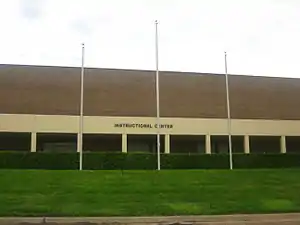Clarendon College (Texas)
Clarendon College is a public community college in Clarendon, Texas. It also operates branch campuses in Pampa and Childress. The college was established in 1898 by the Methodist Episcopal Church, South and administered as a private institution (offering baccalaureate degrees at one point) until 1927 when it became a publicly supported two-year institution.
 Clarendon College Instructional Center | |
| Type | Public community college |
|---|---|
| Established | 1898 |
| Students | 1,135 |
| Location | , , United States 34°56′40″N 100°54′11″W |
| Mascot | Bulldog |
| Website | www.clarendoncollege.edu |
As defined by the Texas Legislature, the official service area of Clarendon College is Armstrong, Briscoe, Childress, Collingsworth, Donley, Gray, Hall, and Wheeler Counties.[1]
History
A Methodist minister, the Reverend W. A. Allen, conceived the idea for Clarendon College in 1879, when he established Allenton Academy at old Clarendon. When the town moved to its present site on the Fort Worth and Denver City Railway in 1887, local citizens offered the Northwest Texas Methodist Conference 4 acres (1.6 ha) of land and promised to build a two-story building to relocate the college. Church leaders made it clear that they would build only if saloons were eliminated from the town. Rev. J. R. Henson, a local Methodist minister, led a campaign, which succeeded by 1902, to clear out the saloons in Clarendon's Feather Hill section and vote Donley County dry.
In 1898, when the town's population was 2,756, construction began on the three-story building that housed president, administration, teachers, and students on Clarendon's 10-acre (4.0 ha) campus. The institution, known as Clarendon College and University Training School, was accepted by the conference and opened in the fall of that year with four teachers and 21 students. Classes were offered in all grades, and primary and intermediate departments existed until 1923. J. W. Adkisson was the first president. Others were W. B. McKeown, J. Sam Barcus, G. S. Hardy, Harley True Burton (the historian of the JA Ranch), J. Richie Mood, G. S. Slover, R. E. L. Morgan, S. H. Condron, and in 1984, Kenneth D. Vaughan.
Despite financial difficulty, by 1900, the school had a faculty of eight, property valued at $8,000, and 109 students. The first interscholastic football game in the Panhandle was played on December 5, 1903, when the Clarendon College Cowboys defeated neighboring Goodnight Academy 16 to 10. After a drop in enrollment in 1914, in 1916 Clarendon College had the largest enrollment of any junior college in the South. By 1919, the physical plant, with two additional frame dormitories and a new administration building, was valued at $175,000, and enrollment reached 350. The school added its third year of work in 1924 and its fourth in 1925 and was recognized as a four-year accredited institution. Baccalaureate degrees, awarded only in 1927, went to 19 students.
After considering proposals to relocate the college at Amarillo, the Methodist Church ceased supervision of the institution on August 15, 1927. School assets, valued at $654,749, were liquidated, and on vote of the citizens, facilities were purchased by the Clarendon school board for the purpose of establishing a municipal junior college. In 1928, a 20% ad valorem tax for support of the school was passed, and later the seven-member board of trustees voted a similar tax for college maintenance. In the 1960s, the college moved to a new location, the former site of the home of pioneer rancher Thomas Sherman Bugbee on a hill west of town. A new building complex was erected, and during the 1966–1967 year, with a faculty of 17, enrollment reached 228.
The Pampa Center, housed in the former Houston Elementary School in Pampa, the seat of Gray County, opened in December 1978 for night classes. Today, the Pampa Center is open for day and night classes and is housed in the new M.K. Brown Academic Center.
In 1979 and 1980, vocational nursing programs were initiated with general hospitals in Shamrock and Childress. In 1980, the main campus maintained administration and classroom facilities, a physical education center, a fine-arts building, a vocational-technological center, three dormitories, a cafeteria, and a library of over 19,000 volumes. During that year, enrollment exceeded 400. A new dormitory, Regents Hall, opened in the fall of 2003 and houses 80 students.

In January 2005, the college built the new Vera Dial Dickey Library on the main campus in Clarendon. Enrollment for the fall 2007 semester was 1,135.
Clarendon College is accredited by the Southern Association of Colleges and Schools and offers liberal arts and agriculture studies, as well as business and other vocational training.
Notable alumni
- Blues Boy Willie, African American blues music singer
- Harold Dow Bugbee, Western artist
- Roy Furr, founder of Furr's chain of grocery stores and cafeterias
- Odell McBrayer, Fort Worth attorney and 1974 gubernatorial candidate
- Radie Britain, musician
- Bill Sarpalius, a former Democratic member of the Texas State Senate and the United States House of Representatives
- Ryan Rohlinger, third baseman San Francisco Giants baseball player
References
- Texas Education Code, Section 130.173, "Clarendon College District Service Area".